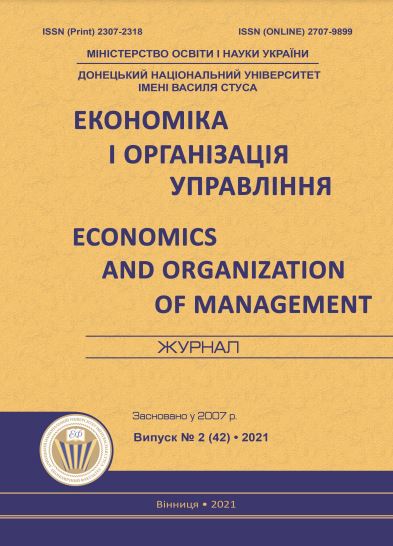Formation of a new paradigm of higher education: drivers and the economic model of universities
DOI:
https://doi.org/10.31558/2307-2318.2021.2.14Keywords:
economic model; new paradigm of higher education; value proposition; financial model; financial stabilityAbstract
The article examines the drivers that define a new paradigm of higher education. Their influence on the strategic directions of university development is substantiated, the irreversibility of transformation processes in higher education is determined, which is caused by: global drivers, which are inherent in the universities of the world; national drivers, which are determined by the educational policy of the state, the level of funding for higher education, competition in the market of educational services, etc .; local, which determine the ability of universities to operate under new conditions, to implement transformation processes, to respond flexibly and to feel the demand of stakeholders.
It is determined that the new paradigm of higher education requires a change in approaches to the organization of activities by university management, the introduction of an economic model based on a value proposition. The article identifies the main components of the economic model (value proposition, key resources, key partners, supply and promotion channels, key activities, key stakeholder groups, financial model and financial stability), their content, identifies the relationships and interdependencies between the components, the influence on the financial stability of the university is substantiated.
References
Internationalisation Agenda for Higher Education, May 14th, 2018. URL: https://www.vsnu.nl/files/documents/Internationalisation%20Agenda%20for%20Higher%20Education.pdf (дата звернення: 14.06.2021).
Halloran L., Friday C. Can the Universities of Today Lead Learning for Tomorrow? The University of the Future. 2018. URL: http://cdn.ey.com/echannel/au/en/industries/government---public-sector/ey-university-of-the-future-2030/EY-university-of-the-future-2030.pdf. (дата звернення: 06.06.2021).
Майбутнє університетів. Частина 1. Еволюція університетів: на порозі невідомого майбутнього URL: https://www.slideshare.net/UIFuture/ss-126507553?from_action=save (дата звернення: 06.06.2021).
Амелін А., Фіщук В., Лаврик Я., Юрчак О., Чернєв Є., Матюшко В. Україна 2030Е – країна з розвиненою цифровою економікою. URL: https://strategy.uifuture.org/kraina-z-rozvinutoyu-cifrovoyu-ekonomikoyu.html#6-2-9 (дата звернення: 20.06.2021).
Юрчишена Л.В. Принципи корпоративного управління: міжнародний досвід та впровадження в університетах. №8. 2020. DOI: 10.32702/2307-2105-2020.8.53.
Cruz-Amaran D., Guerrero M., Hernandez-Ruiz A. D. 2020. Changing Times at Cuban Universities: Looking into the Transition towards a Social, Entrepreneurial and Innovative Organization. Sustainability, MDPI, Open Access Journal, vol. 12(6), pages 1-1, March.
Daniela Baglieri, Francesco Baldi, Christopher L. Tucci. University technology transfer office business models: One size does not fit all. Technovation, vol. 76–77, 2018, Pages 51-63. DOI: https://doi.org/10.1016/j.technovation.2018.05.003 (дата звернення: 14.06.2021).
Соколовська А. М. Шляхи розширення фінансової автономії університетів // БИ. 2018. №4 (483). URL: https://cyberleninka.ru/article/n/shlyahi-rozshirennya-finansovoyi-avtonomiyi-universitetiv (дата звернення: 05.07.2021).
Юрчишена Л. В. Визначення бізнес-моделі університету на основі синтезу підходів до бізнес-моделі підприємства. Економіка і організація управління. 2020. № 4 (40). С.271-284. DOI: https://doi.org/10.31558/2307-2318.2020.4.25.
Radecki, J. University Budget Models and Indirect Costs: A Primer. Ithaka S+R. 25 February 2021. DOI: https://doi.org/10.18665/sr.314858.
Pursglove J., Simpson M. A model of university financial performance. International Journal of Business Performance Management, Inderscience Enterprises Ltd. 2001. vol. 3(1), pages 1-15. DOI: 10.1504/IJBPM.2001.000087.

